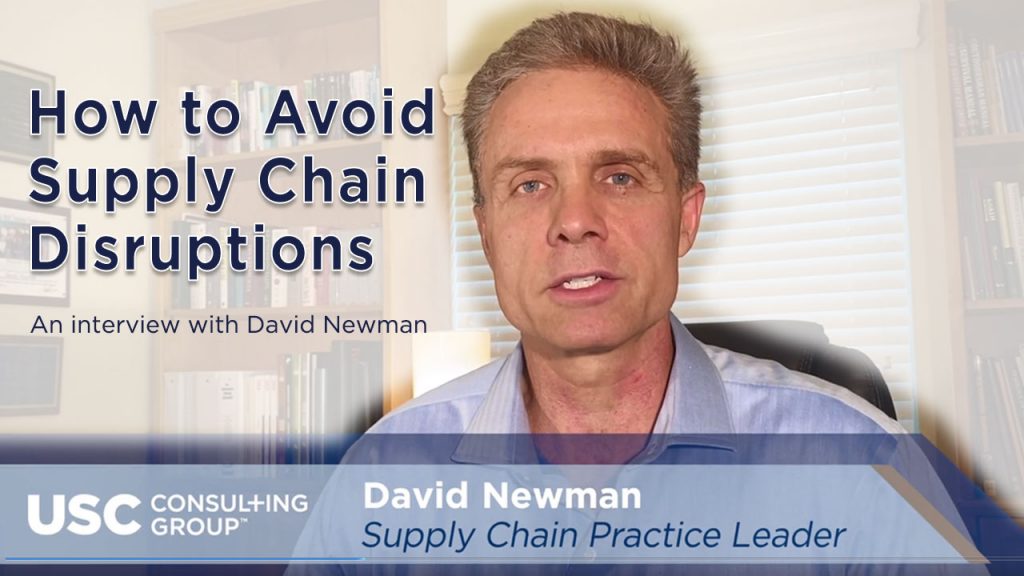
How to Avoid Supply Chain Disruptions – An Interview with David Newman (video)
Supply chain disruptions have been a major challenge for manufacturers, and show no signs of abating. Here, David Newman, Supply Chain Practice Leader for USC Consulting Group, shares his insights into this pressing issue and offers tactics manufacturers can use to mitigate disruption risks.
QUESTION: “How have supply chains evolved over your career?”
DAVID NEWMAN: A lot has changed since I started in supply chain. 30 years ago the primary focus was on supply base optimization which sowed the seeds for single source supply bases. 20 years ago online retailers began to re-define fulfillment, distribution, and delivery optimization. Over the last 10 years, big data, the internet of things and machine to machine transactions have driven out inefficiencies out of the most competitive supply chains.
QUESTION: “What are the key supply chain concerns facing manufacturing companies today?”
DAVID NEWMAN: Among the three pillars of supply chain, COST, QUALITY, and DELIVERY – Delivery is taking center stage – and specifically, delays caused by disruption. On a trip to China, our driver pointed out of the window and said, “In this Province, China produces 40% of the world’s ceramic tile.” Now, when a highly centralized, efficient supply chain with overseas lead times meets a global pandemic and governments mandate that cities and provinces stay home for a month, there are going to be supply chain disruptions.
QUESTION: “What can Supply Chain Managers do to mitigate supply disruption risks?”
DAVID NEWMAN: Supply chain disruptions cause uncertainty. Generally speaking, there are five types of solutions supply chain managers employ to decrease uncertainty and to improve reliability in their supply chain: There are 1. TIME solutions, 2. PRICING solutions, 3. PRODUCTION solutions, 4. INVENTORY solutions, and 5. INFORMATION solutions.
The most common and easiest to employ are the TIME solutions. Things like expediting freight (which is a supply side response), or delaying order fulfillment (which is a demand side response). But, if your customers have other options and they have low customer loyalty, delaying delivery dates can significantly reduce your revenues. Alternatively, premium freight if you have a low margin product, can wipe out profits.
PRICES for hard to get commodities skyrocket during times of uncertain supply contributing to cost inflation. If these costs can’t be passed on to customers, margins suffer. Time and price-based solutions tend to be the easiest and quickest solutions, which is why they are most often employed in emergency situations.
PRODUCTION solutions include flexible manufacturing and quick changeover practices, having alternative suppliers and substitute materials, reducing quality rejects in order to have more saleable product, and improving the source, make and deliver cycle times. These solutions are effective during times of certain supply, but when dealing with disruptions, they’re often too little, too late.
QUESTION: “Why don’t companies just increase stockpiles?”
DAVID NEWMAN: Increasing INVENTORIES is a common response to disruptions, however there are often constraints in the warehouse and storage space. Excessive inventories drain cash and they tie up working capital. Times of uncertainty require regular reorder point and order quantity reviews in light of changing lead time demands. We find too often that manufacturers will rely on their suppliers for reorder points and order quantities. A better practice is to use statistical analysis to evaluate how changing lead times are affecting the reorder points and order quantities in your ERP system. The best practice utilizes machine-to-machine learning algorithms that update automatically according to consumption data and lead time data.
QUESTION: “What new types of information do responsive supply chain employ?”
DAVID NEWMAN: Uncertainty is nothing more than the absence of correct and timely INFORMATION. Executing on technology and process solutions to improve supply chain information is sometimes viewed as expensive, however it is rarely more expensive than increasing investments in facilities and equipment, or habitually discounting obsolete inventory, or perpetually incurring premium freight.
Some commonly used practices and tools to improve supply chain information include embedding a strong SIOP process – Sales, Inventory, and Operations Planning. Conducting Value Stream Maps to understand the tiered network of the supply chain, implementing strong Supplier Scorecards, and having a robust Risk Register process where there are early warning systems, contract optionality, and redundancies in the supply base, especially around critical parts and materials.
QUESTION: “Can’t I just rely on my Strategic Suppliers to keep me stocked?”
DAVID NEWMAN: Although supply chains have been improved significantly in the past 30 years with technology, supply chain disruptions are still managed by people. Developing key relationships with your strategic suppliers will ensure that there’s someone on the other end of the phone when you call regarding delivery dates. However, if daily phone calls is your go-to strategy, it’s not enough to ensure continuity in supply in our increasingly complex and disruptive supply chains.
How could your company benefit if presently disjointed internal functions and your supply chain partners shared connected, real-time information?
What if your team had data driven, scenario analysis tools to make rapid responses that provide optimum outcomes?
What if the supply chain drivers that most affect your business performance were translated into metrics for operations and supply chain accountability?
If your company needs help reducing supply disruptions, turn to the supply chain experts at USC Consulting Group. We have been empowering our clients’ performance for over 50 years.






